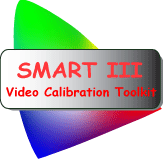SMART III - Video Calibration Toolkit
Steve Smallcombe's SMARTAVTWEAKS site

SMART III for DLP-based Projectors
While SMART was developed using an LCD-based projector, the SONY 10HT, its usefulness extends to many other types of projectors as well. In fact, SMART III is particularly well suited for use with DLP projectors where the high dynamic range of SMART’s light meter-based detector is a very good match for the high contrast ratios associated with DLP projectors.
So say you have a projector with a contrast ratio of 2000:1. What measurement
range do you need in the detector to accurately measure the contrast ratio
or the low-level color balance? Is a detector with a measurement range
of a few thousand to one good enough? Not really. Let’s say that
the resolution or detection limit of the detector is one unit. If you
make measurements, e.g. of a black level that are only a few units, changes,
e.g. from 2 to 3, can swing the measurement of contrast ratio by 50%!
Clearly for accurate measurements, all light levels should be measured
well above the minimum possible reading for that detector, ideally by
a factor of 100 or more.
Unfortunately because of limited dynamic range, most all devices meant
to measure color cannot accurately measure a contrast ratio of more than
a few hundred to one, or color balance at low IRE levels with modern projectors.
Detector linearity can also be a problem with many color detectors at
low light levels and small tweaks can sometime produce surprising (and
unbelievable) results.
As the contrast ratio performance of projectors has steadily improved
over the years, this problem has become more acute. SMART started as a
very simple do-it-yourself approach using photocells and colored filters.
This worked well with the 10HT, but as I started looking at projectors
with higher contrast ratios, and realized the importance of accurately
measuring low-level color balance, SMART needed something better. It was
actually Bill Cushman that recommended that I switch to the AEMC meter
that we now use for SMART III, as it has a dynamic range of 2 million
to 1. (The Extech meter we also use is equally good.) These meters are
very linear and one can accurately measure contrast ratios of many thousand
to 1 with very good accuracy, as well as the color balance at IRE 0! (You
may have noticed that SGHT now uses light meters to measure contrast ratios
as well rather than relying on their professional color meters.)
This high dynamic range and linearity is also very good for measuring
gamma and gamma tracking, another important characteristic of projectors
that is critical in getting a accurate image, but again poorly measured
using other color measurement systems, especially gamma tracking at low
light levels.
For these reasons I have just introduced a new “DLP” version
of SMART 1.2 in which I have incorporated improved gamma tracking calculations
and the changes necessary to deal with the different spectral characteristics
found with typical DLP bulbs and color wheels. These changes are based
on the DLP projectors that I have either reviewed or measured using SMART.
While previous version of SMART worked well with DLP, these changes should
make SMART work even better with DLP-based projectors.
Introduction to how SMART works
Frequently Asked Questions about SMART
Here is what's new is SMART III version 1.2
The Dummies Guide explains the SMART process in a non-technical way
Buy SMART III at EnhancedHT - your exclusive source for all SMART products
Having trouble? Learn the most common mistakes people make using SMART
Read about using bias lights to improve perceived black levels.
Here are some additional tips for the SONY projectors and solution to common problems.